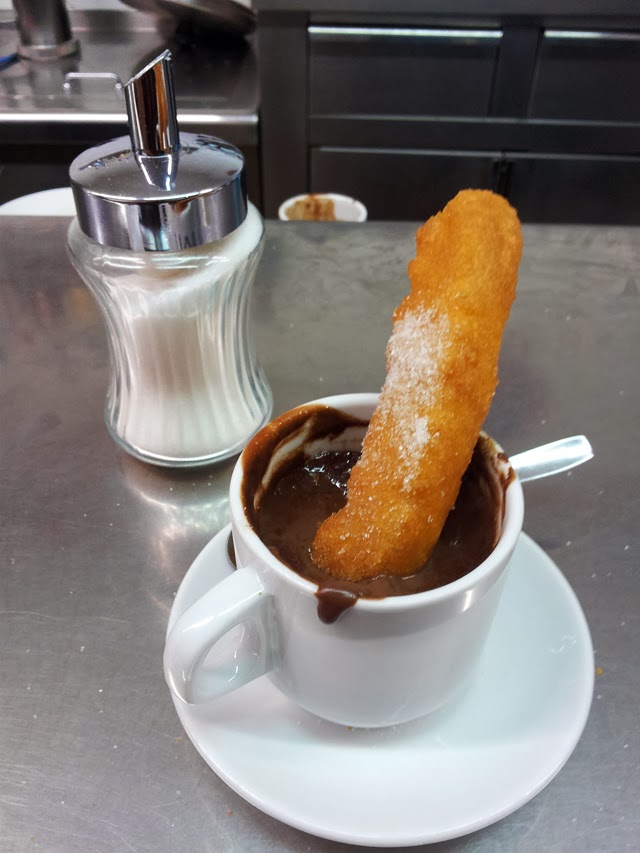 |
| Porras with chocolate in Barcelona |
If you fancy secret places out of the touristic routes, places not so charming but equally exquisite because of the quality of the product you get and if you cannot leave Barcelona without tasting those porras or churros with chocolate somebody was bragging about just before you came visit us, then you should know that there is this small cafe, frequented by locals, very near Metro stop Fabra i Puig (Red Line) called Churreria Laia (carrer Malgrat 82)(Passeig de Fabra i Puig, 146) where you can satisfy your most guilty pleasures.
For those of you that don't know what a churro is, let me tell you that it is just dough made right in front of you by mixing flour, hot water and salt inside a blending machine made for such purpose. Once the dough is ready, some portions are placed inside another machine called churrera that pipes everything through a star-shaped nozzle that gives it that characteristic prism-like shape. The dough comes out of it as if it were tooth paste slowly making a spiral that is then fried and served hot. You usually sprinkle sugar on top.
For those of you that don't know what a churro is, let me tell you that it is just dough made right in front of you by mixing flour, hot water and salt inside a blending machine made for such purpose. Once the dough is ready, some portions are placed inside another machine called churrera that pipes everything through a star-shaped nozzle that gives it that characteristic prism-like shape. The dough comes out of it as if it were tooth paste slowly making a spiral that is then fried and served hot. You usually sprinkle sugar on top.
Update 07/2023:
'Porras differ from churros because they contain an extra ingredient: baking soda or, in some cases, yeast. The dough for the porras contains flour, salt, water and baking soda and we must leave it to rest for a period of several minutes before putting it in the fryer in order to release carbon dioxide and result in a much softer dough. . There is also a difference in the proportion of flour in relation to the amount of water: the amount of water is higher in the mass of the porras. Churros are loop-shaped, thin in thickness, and have a dense dough. Instead, the porras are fried in the form of large spirals and then cut into pieces; they are thicker and spongier because they have air inside.' - according to Churreria Desi
So Porras, which are very popular in Madrid (and other regions of Spain, check this post from Valencia about the difference between churros and porras), are not just thicker as you can see in this image but carry that extra ingredient. In Madrid, porras are a staple of the local cuisine and are often consumed for breakfast or as a mid-morning snack. The result is a heavenly treat that pairs perfectly with a cup of thick, rich hot chocolate. Madrid boasts numerous traditional cafés and pastry shops where locals and visitors alike can indulge in the pleasure of porras. One of the most renowned establishments is San Ginés, a charming café located near Puerta del Sol. San Ginés has been serving porras since 1894 and is often crowded with clients eager to experience the iconic combination of porras and their famous hot chocolate. The porras in Madrid tend to be thick, dense, and slightly chewy, providing a satisfyingly substantial bite.
So Porras, which are very popular in Madrid (and other regions of Spain, check this post from Valencia about the difference between churros and porras), are not just thicker as you can see in this image but carry that extra ingredient. In Madrid, porras are a staple of the local cuisine and are often consumed for breakfast or as a mid-morning snack. The result is a heavenly treat that pairs perfectly with a cup of thick, rich hot chocolate. Madrid boasts numerous traditional cafés and pastry shops where locals and visitors alike can indulge in the pleasure of porras. One of the most renowned establishments is San Ginés, a charming café located near Puerta del Sol. San Ginés has been serving porras since 1894 and is often crowded with clients eager to experience the iconic combination of porras and their famous hot chocolate. The porras in Madrid tend to be thick, dense, and slightly chewy, providing a satisfyingly substantial bite.
Moving to Barcelona, although you can find porras as such, more than often you will end up having our churros or xurros with different form and texture. The dough used for churros is typically made with a higher proportion of water, resulting in a lighter and crispier end product. In other words, although you can find porras or what looks like porras but carrying a filling (which is not a porra), churro or a xurro in Catalan, is the usual thing to have. Anyway, porras you can find.
Xurrerias, specialty shops that specialize in churros and sometimes offer porras, can be found throughout Barcelona. These establishments attract locals and tourists with the enticing aroma of freshly fried dough. One popular xurreria is the iconic Xurreria Trebol, located in carrer Corsega 341.
Do you have porras in your city? Spanish porra also refers to the sticks or batons carried by the police so I am sure you have some porras and they don't serve it with chocolate!
![Barcelona Sunset [enlarge]](http://lh4.googleusercontent.com/-DBssW6sR7bo/UkvoyQDqIKI/AAAAAAAAFrI/2ytqJlg64Fs/w640-h480-no/picsay-1380705348+640.jpg)
